In a city as old as Norwich some of the more interesting glimpses into its past are to be found in the historically significant names given to streets.
Hotblack Road NR2 (off Dereham Road)
The uncommon name, Hotblack, which conjures up images for me of road-laying, tar, and snooker on the telly, commemorates the family of John Hotblack who was a boot and shoe manufacturer in the C19 when Norwich was still one of the country’s major shoe producers. Hotblack’s factory was in Mountergate, off Rose Lane, not far from the large Co-op shoe factory.

At top, one of the very few weavers’ windows remaining in the city
The Hotblack family lived next door in St Faith’s House.
![Mountergate St Faith's House [1168] 1936-07-27.jpg](https://colonelunthanksnorwich.com/wp-content/uploads/2019/09/mountergate-st-faiths-house-1168-1936-07-27.jpg?w=529)
St Faith’s House in Mountergate 1936, home to the Hotblacks around the 1890s ©georgeplunkett.co.uk
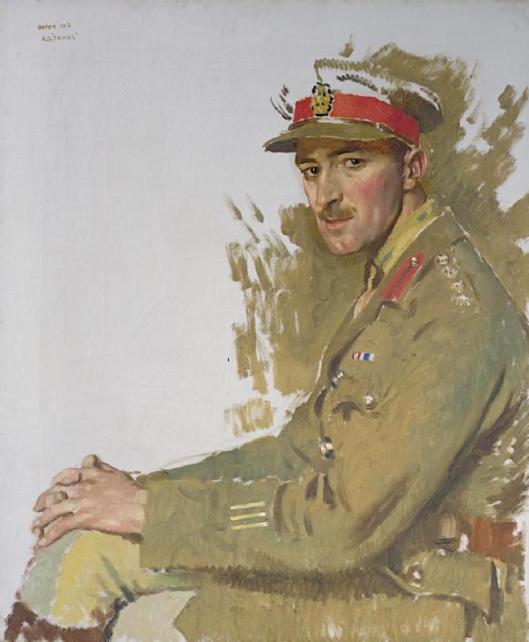
‘Boots’ by Sir William Orpen 1917. Courtesy of the Imperial War Museum
Lyhart Road NR4
In 1463, lightning struck the central tower of Norwich Cathedral, setting fire to the roof in the crossing, causing the spire to crash down into the nave. In the 1470s the Bishop of Norwich, Walter Lyhart, replaced the wooden roof with a vaulted roof of stone, using some of his own money to employ stonemason Reginald Ely, who had worked on King’s College Chapel, Cambridge [2]. Lyhart’s contribution is commemorated in his rebus of a hart lying on wa(l)ter.
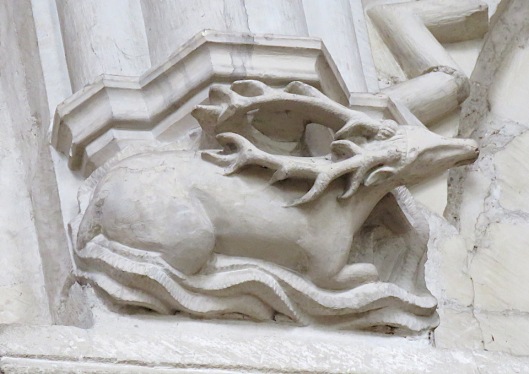
Another lying hart can be seen amongst the wonderful collection of roof bosses in the cloisters. The cloisters were damaged in the riots of 1272 and the restoration, which was halted by the Black Death, stretched over the fourteenth and fifteenth centuries. 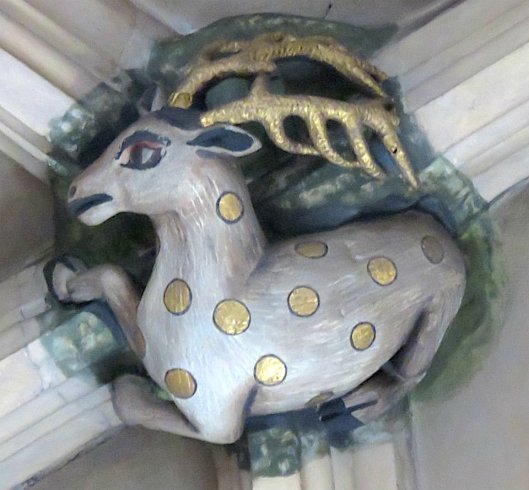
Bishop Lyhart also oversaw the installation in the nave of 255 stone bosses that mark the intersection of short lierne ribs with the main ribs of the vault. The bosses represent biblical scenes, from the Creation to the Last Judgement. A favourite of mine is the overthrow of the Pharaoh in the Red Sea; it shows the Pharaoh’s chariot – looking more like a farm cart – in a literally red sea.
There was a time when Lyhart’s rebus could be seen in the tower screen at Yaxley, Suffolk [3]. In the same screen was another piece of stained glass depicting the head of a bishop. Could this have been Walter Lyhart himself?
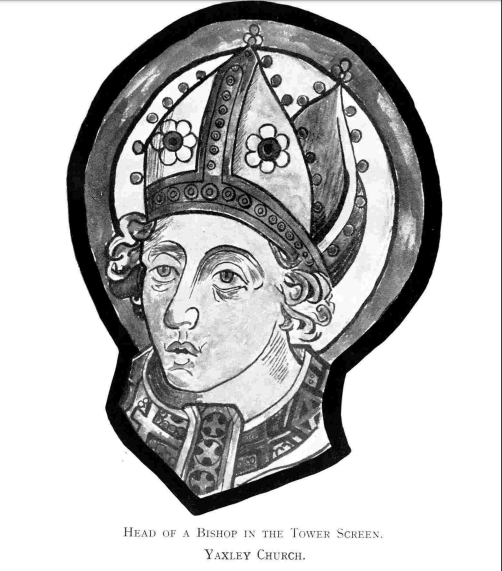
From ref [3]. 1932
Major figures of the Norwich School of Painters (see previous post [4]) are well represented on road signs – for example, Cotman Road NR1, Crome Road NR3, Ladbrooke Place NR1 – but each time I travel clockwise around the ring road I am reminded of a less-well-known artist, Thomas Lound.

Early collodion positive of Thomas Lound 1850s
Lound (1802-1861) was a painter and etcher of local landscape but instead of scrabbling for a living, as many members of the Norwich Society of Artists did, he worked as a manager in the family brewing business and actually died with money in the bank. He was employed by the brewery of Tompson, Stackhouse & Co on King Street [5]. In 1844, Tompson’s was sold to the Morgan brothers, one of whom, Walter, drowned in a brewery vat [6]. Morgan’s was one of the ‘Big Four’ Norwich breweries in the first half of the C20.
Lound was taught by John Sell Cotman, whose influence can be seen in Lound’s paintings, though he probably followed more in the footsteps of Thirtle, whose work he collected avidly [7].
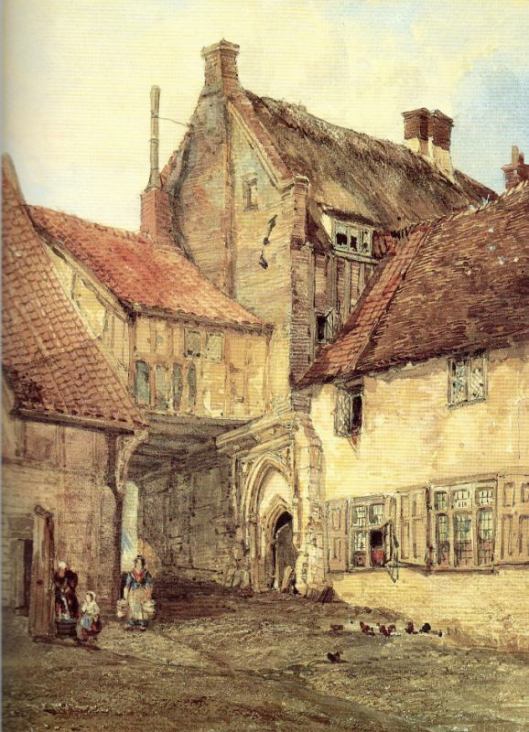
View from Old Barge Yard by Thomas Lound (1850) shows the back of what is now called Dragon Hall, near his home in King Street. The open door (centre) is part of the original C14 doorway within the larger C15 ‘blind’ door-surround installed by Robert Toppes when the building was used as his wool-trading hall.
In 1839, six years after the demise of the Norwich Society of Artists, Lound became co-founding President of the Norwich Art Union [8] that – if it was anything like the Art Union of London – used subscriptions to buy works of art to be distributed amongst members by lottery. Lound was also involved in the Norwich School of Design (1846), a predecessor of the Norwich Technical Institute (1899) on St George’s Street, which is now part of the Norwich University of the Arts (NUA). In its first year the Art Union held an exhibition in its gallery at The Bazaar near the corner of Bridewell Alley and St Andrew’s Street [8].
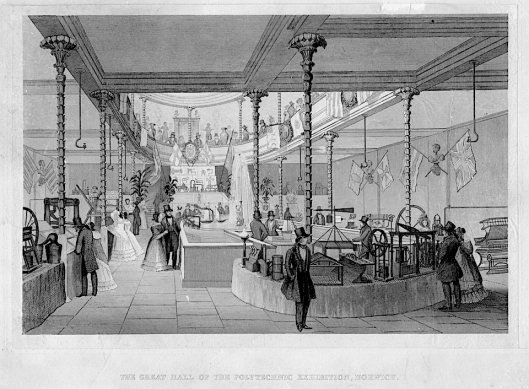
The Great Hall of the Polytechnic Institution, The Bazaar, Norwich. Courtesy of Norfolk County Council at Picture Norfolk
(Added 5/10/2019) The Classical façade of The Bazaar is highlighted on this mid-Victorian photograph.
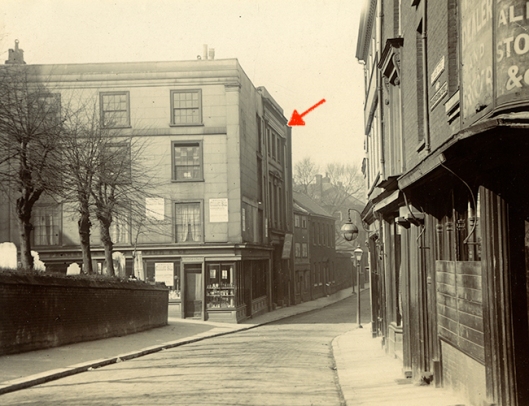
St Andrew’s Street with The Bazaar, arrowed. The tombstones are in the churchyard of St Andrew’s. Courtesy of Norfolk County Council at Picture Norfolk.
The Bazaar is long gone but by one of those pleasing circularities its former site on the corner of Bridewell Alley and St Andrew’s Street is now occupied by NUA’s East Gallery.
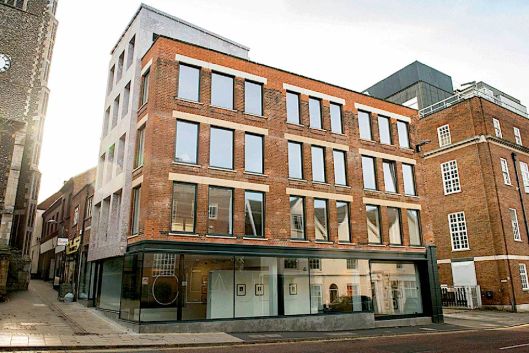
East Gallery, site of former Royal Bazaar. Courtesy of NUA
Thomas Lound was also on the committee of the Norwich Photographic Society. In 1856 he exhibited five of his own photographs including one of Norwich Fish Market [8].

The Fish Market, Norwich by Thomas Lound, reissued as a postcard by AE Coe Opticians and Photographers. Courtesy of Norfolk County Council at Picture Norfolk
Bathhurst Road NR2
Bathurst Road at the city end of Unthank Road was built on the Heigham Lodge Estate that once belonged to Timothy Steward of Steward & Patteson’s Brewery. In 1877 architect Edward Boardman divided Steward’s former land into lots for sale. Three roads were laid around the estate, one of which – temporarily named Grove Street North – was renamed Bathurst Road after Bishop of Norwich, Henry Bathurst (1744-1837).
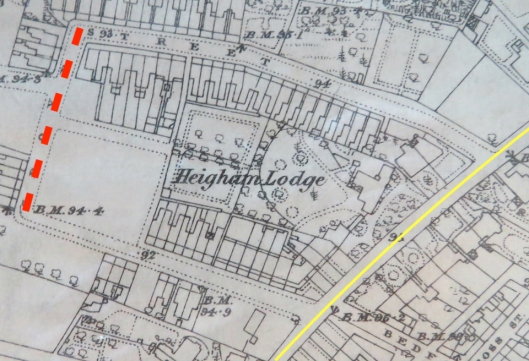
Bathurst Road (red) runs parallel to Unthank Road (yellow). Ordnance Survey 1883
As described in Colonel Unthank and the Golden Triangle [9], Heigham Lodge was mistakenly thought to have been the home of William Unthank, who had bought 60 or so acres in Heigham to establish the Unthank Estate. William Unthank and Bishop Bathurst both died in 1837.
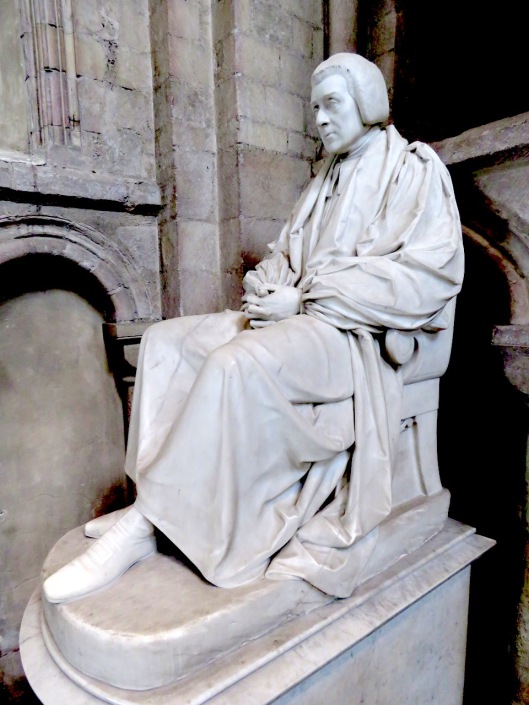
Memorial statue to Bishop Bathurst in north transept of Norwich Cathedral
After the Reformation, Dissenters were banned by the Church of England from burial in their parish church. But in 1821, Bathhurst licensed Norwich’s Rosary Cemetery as the first non-denominational burial ground in the country (see [10] for The Norwich Way of Death). This chimes with Henry Bathurst’s reputation as the only liberal bishop in the House of Lords and as someone who supported Catholic Emancipation.
Since their Oxford days, Henry Bathurst had been friends with Parson James Woodforde (1740-1803) of Weston Longville, about seven miles north-west of Norwich. When Bathurst was non-resident Rector of nearby Great Witchingham, Woodforde would collect surprisingly large tithes on his behalf. In his absorbing Diary of a Country Parson, Woodforde wrote:
About noon took a ride to Norwich … and dined, supped and slept at the King’s Head. As soon as I got to Norwich I went to Kerrison’s Bank and there recd. for cash etc a Note of £137 (about £8,000 today) which I immediately inclosed in a letter to Dr Bathurst, Oxford. I walked to the Post Office, and put the letter into the Post which sets for London this evening at 10 o’clock. I then went to the King’s Head and eat a Mutton Chop and before I had quite dined Mr Hall came to me, and we smoked a pipe and drank a Bottle of Wine [11].
Harvey Lane NR7
… named after Colonel John Harvey (1755-1842) who moved from the city centre to Thorpe, a few miles east of the city [12]. Harvey came from a long line of wealthy Norwich textile merchants who had turned to banking: he himself was a leading partner of Harvey & Hudson’s Bank. Like nine of his relatives, Harvey became Mayor of Norwich (1792) but in his mayoral portrait he chose to be portrayed as colonel of the local militia.

Colonel John Harvey 1792, painted by John Opie RA, fashionable portrait artist and husband of Norwich abolitionist, Amelia Opie. Presented by the Norwich Light-Horse Volunteers. Courtesy Norfolk Museums Collections NWHCM: Civic Portrait 33
We encountered Colonel Harvey last month in the large oil painting he commissioned from Joseph Stannard: ‘Thorpe Water Frolic, Afternoon’ (1825) [4]. Harvey instigated The Frolic in 1821, largely as a sporting event for the gentry, but opened it up to the working population two years later when city weavers were given a day’s holiday. 10,000 are said to have attended: polite society on the Thorpe side, workers on the opposite bank [12]. Last time, I focussed in on Stannard on the right bank, peering across to the gentry but here we see Harvey peering back from the left.

A fragment of ‘Thorpe Water Frolic, Afternoon’ by Joseph Stannard, showing the white-haired colonel in his Venetian gondola. Courtesy Norwich Castle Museum and Art Gallery
Harvey did not live on the riverside in Old Thorpe Hall – only parts of which remain – but at Thorpe Lodge, a five-bayed house that he built on the other side of the highway, re-routing the Yarmouth Road in the process [12]. In the 1930s the central third storey was removed and the east wing demolished; it now houses the Broadland District Council.
![Thorpe St Andrew Thorpe Lodge [5423] 1974-09-14.jpg](https://colonelunthanksnorwich.com/wp-content/uploads/2019/10/thorpe-st-andrew-thorpe-lodge-5423-1974-09-14.jpg?w=529)
Thorpe Lodge 1974 ©georgeplunkett.co.uk. In the 1930s the curved east wing was removed along with the third storey of the central bay.

Photographed in the garden wall of Thorpe Lodge 1948, a Tudor door from the home of Mayor George Cocke (1613) at Bacon’s House, Colegate. The left-hand spandrel contains the Grocers’ arms, the right contains Cocke’s initials as part of his merchant mark. From [13].
In 1792 the Royal Mint was unable to obtain sufficient silver for coinage. Harvey responded by minting Norwich trade tokens from base metal, their value no doubt backed by the Harvey & Hudson bank. This can be seen as a philanthropic way of keeping the city’s trade flowing although the loom on the reverse of the coin would also have served to advertise Colonel Harvey’s role in the local economy during his mayoral year [15].
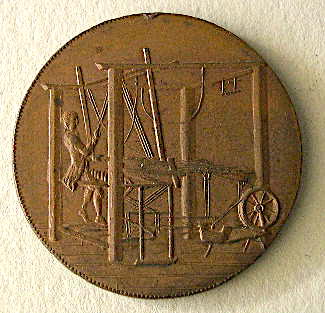
The reverse of a Harvey token shows a hand-loom, the obverse shows the Norwich City coat of arms, the rim is impressed with Harvey’s name. Norfolk Museums Collection NWHCM : 2006.79.1
Onley Street NR2
The Harveys were related to the Unthanks but to understand the origins of this street name we have to untwist the limbs of the Harvey family tree.
Colonel Harvey’s brother Charles (1757-1843) dropped the surname Harvey when he inherited Stisted Hall in Essex from his uncle, the Reverend Onley. The Reverend had himself adopted his wife’s family name, Savill, making him a Savill-Onley. Double-barrelled names were often adopted to preserve a family name that would otherwise have died out due to lack of male heirs or, in the case of Reverend Savill-Onley, ‘in appreciation of the fortune (£33,000) his wife had brought with her’ [16].
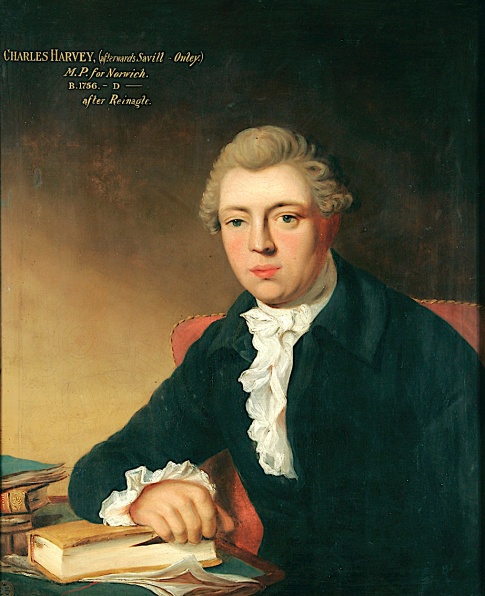
Charles Harvey, MP for Norwich, later Savill-Onley. Courtesy Norfolk Museums Collections THEHM:DS.25
When Charles Savill-Onley died his son adopted the name of Onley Savill-Onley [17].

Onley Savill-Onley Esq 1795-1890. From [16].
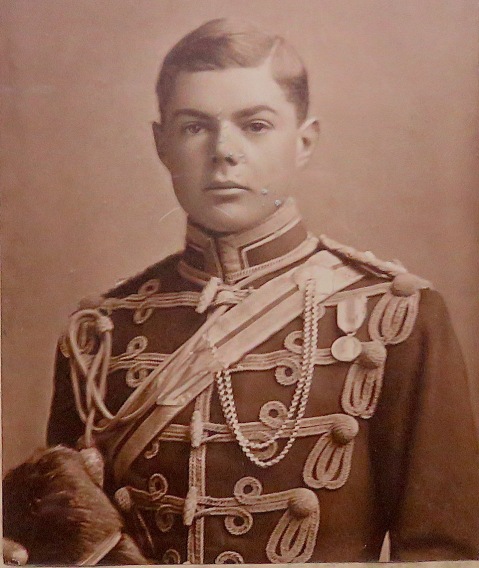
Clement William Onley Unthank ca 1900. From [9].
To be continued …
©Reggie Unthank 2019
–––––––––––––––––––––––––––––––––––––––––––––––––
‘An excellent Christmas-stocking filler’. The book Colonel Unthank and the Golden Triangle, which contains more about the Unthank family and describes the development of the the streets either side of Unthank Road, is still available from: Jarrolds’ Book Department (https://www.jarrold.co.uk/departments/books); or City Bookshop in Davey Place (http://www.citybookshopnorwich.co.uk/); or direct from me via the contact form (https://colonelunthanksnorwich.com/contact/).

Sources
- https://www.edp24.co.uk/features/norfolk-war-hero-who-was-too-brave-1-4801801
- Paul Hurst (2013). Norwich Cathedral Nave Bosses. Pub: Medieval Media, Norwich.
- Christopher Woodforde (1932). The Medieval Glass in Yaxley Church. Suffolk Institute of Archaeology and Natural History vol XXI pt 2.
- https://colonelunthanksnorwich.com/2019/09/15/the-norwich-school-of-painters/
- https://suffolkartists.co.uk/index.cgi?choice=painter&pid=4128
- https://www.norridge.me.uk/pubs/names_/brewers/morgan.htm
- Josephine Walpole (1997). Art and Artists of the Norwich School. Pub: Antique Collectors’ Club.
- http://www.earlynorfolkphotographs.co.uk/Norwich%20Photographic%20Societies/Norwich_Photographic_Societies.html
- Clive Lloyd (2017). Colonel Unthank and the Golden Triangle. ISBN 978-1-5272-1576-4
- https://colonelunthanksnorwich.com/2018/10/15/the-norwich-way-of-death/
- https://archive.org/stream/in.ernet.dli.2015.227134/2015.227134.The-Diary_djvu.txt
- Trevor Nuthall (2014). Thorpe St Andrew: A Revised History. Pub: Trevor Nuthall ISBN 978-0-9543359-1-5.
- Arnold Kent and Andrew Stephenson (1948). Norwich Inheritance. Pub: Jarrolds and Sons Ltd.
- Walter R Rudd (1923). The Norfolk and Norwich Silk Industry. Norfolk Archaeology vol XXI, pp245-282.
- Katy Barrett. Eighteenth Century ‘Hand-Loom’ Token. Analysing the English Collections at the Pitt Rivers Museum. https://england.prm.ox.ac.uk/englishness-token.html
- Reverend A J Nixseaman (1972). The Intwood Story. Printed in Norwich by RR Robertson.
- https://www.jjhc.info/harveyjohn1842
Thanks. I am grateful to Clare Everitt of Picture Norfolk, Ken Skipper of Cork Brick Gallery Bungay and the George Plunkett archive (www.georgeplunkett.co.uk).

Fascinating and informative as ever. Thank you.
LikeLike
Thank you for the kind words Jeremy
LikeLike
Opie Street is one that I’d like to learn more about.
LikeLike
There’s more about Amelia Opie in https://colonelunthanksnorwich.com/2017/03/15/three-norwich-women/
Have you seen the new (to Norwich) John Opie double portrait of Amelia in the Castle Museum?
LikeLike
Thanks for the references which I’ll read with interest. No I’ve not been to the Castle for a couple of years (last time was for the Paston treasure.)
LikeLike
Very interesting – thank you! I’ve often considered there’s a lot of Norwich road and street names which could be researched John
LikeLike
My next post will be a continuation of this theme John. Suggestions welcome.
LikeLike
Great blog Reggie!
Always wondered about Hotblack Road…now I know.
Lots of other potential street names up your sleeve?
Sally
LikeLike
I have a few names ready for the next post, Sally. Do you have suggestions?
LikeLike
Especially enjoyed the connection to Parson Woodforde – thanks!
LikeLike
Hi Caroline, I find Woodforde’s diary fascinating and am a great fan of the @JamesWoodforde1 Twitter feed.
LikeLike
Fascinating stuff, Reggie! I also enjoyed the link to Parson Woodforde, to whom I am devoted!
LikeLike
Yes, Woodforde is a favourite. Could he be worth a blog post of his own?
LikeLiked by 1 person
Yes, definitely!
LikeLike
One of the juiciest and most interesting! I do hope this will be a substantial series!
LikeLike
Hello Heather, It just so happens I am working on Streets#2.
LikeLike
Fascinating as always – keep up the good work – this series could run and run!
LikeLike
Suggestions welcome, Grant
LikeLike
Very interesting post (I came over via a comment you posted in Clare Pooley’s blog), and now I’m hooked! A blog to wile away hours when I should be doing other things! (That’s a compliment.) I love the portrait of Colonel John Harvey with his horse. I wonder if it has been restored as it looks so fresh. I was watching a video recently of historic fine art paintings being intricately and very carefully restored, it’s fascinating. Would you like a link to it?
I became interested in Norwich only recently while trying to research an unknown house in an RP photo I bought and, as usual, got diverted (in awe) of your neighbourhood.
LikeLike
Hello Val, I am delighted the blog is keeping you from more gainful pursuits. The Harvey portrait is a gem but I don’t know if it has been recently restored. The more I see of Opie’s paintings the more I like him. Please send the link via Contact. Reggie
LikeLike
There are some wonderful street names in Norwich, some now lost like Winkles Row and Cinder Oven Row as well as both Goat Lanes and (perhaps best of all) Labour in Vain Yard. Your research is excellent, keep a’goin bor!
Don Watson
LikeLike
I also like the names of lanes in the countryside around the city eg Cutpurse Lane, and must start collecting them. I hadn’t heard of Cinder Oven Row. Was that near Gas Hill, where there are some houses made of cinder from the gasworks (of which there were more than one)? Reggie
LikeLike
It was off King St near Darrow Bridge as was Winkles Row. The naming of Streets in Norwich is a wonderful and random thing thanks to many centuries of growth
Don Watson
LikeLike
Thank you for the information Don.
LikeLike
Pingback: The Norwich Banking Circle | COLONEL UNTHANK'S NORWICH
Pingback: Parson Woodforde and the Learned Pig | COLONEL UNTHANK'S NORWICH
Great read, very interesting. I was trying to find out the reason behind Kerrison Road, no luck anywhere unfortunately
LikeLike
I assume this refers to the Kerrison of Kerrison’s Bank used by Parson Woodforde in his diary (see: https://archive.org/stream/in.ernet.dli.2015.227134/2015.227134.The-Diary_djvu.txt).
Also see: https://colonelunthanksnorwich.com/2020/02/15/the-norwich-banking-circle/
Are you related to this banking family?
LikeLike